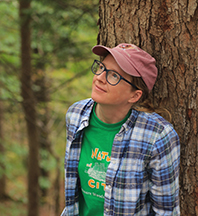Week of January 26, 2025 – February 1, 2025
by Anna Stunkel, Environmental Educator
With most leaves gone from deciduous trees during winter, this is the perfect time to appreciate tree bark. Without the distraction of greenery everywhere, you might notice the great variety of bark protecting the trees around us. It can be smooth like a beech, platy like a sycamore, rough like a maple, or shiny and peeling like a birch. Each tree is adapted to growing and surviving in different ways. Bark helps to protect trees from pests, diseases, and extreme weather events.
Some bark such as that on birches and young cherries is adorned with lenticels, which are small horizontal lines that help the tree to “breathe” by facilitating gas exchange. Bark thickens as it grows outward from the inner cambium layer. As many trees age, their bark becomes rougher and more furrowed.
As we admire the beauty and diversity of tree bark, we might also think about connections to our own lives as humans. We must experience many changes and stressors throughout life, finding different ways to cope with them as we grow. Like trees that grow thicker bark as they age, we learn how to handle new challenges each day. But we can’t shield ourselves from every challenge and need to be open to the environment around us, just like trees. Trees need both bark to protect themselves and lenticels to “breathe.”
We might have different strategies for turning inward and caring for ourselves such as meditating or enjoying a good book. During this chilly and, in Central New York, often cloudy time, it makes sense for our bodies to slow down and almost hibernate. In this way, it is kind of like we are cocooning ourselves just as the trees protect themselves with bark. And like the trees with their different patterns and textures, this self care is different for every person. Even as tree bark develops scars, or is even drilled for maple sugaring, it continues to grow just like we do.
Like the lenticels of a tree, we must also find ways to connect with the environment around us. This could be by spending time in nature and finding new ways to appreciate it or volunteering to help your community. Interacting with our environment in various ways allows us to grow and expand our awareness.
Next time you have a spare moment, spend some time with a tree. Feel its bark, maybe closing your eyes to focus on the texture. Think about how that tree’s bark has grown and changed throughout its life, maybe becoming more calloused like the hands of a hard-working farmer (or a stewardship volunteer helping out on our trails!) In the spring, its buds will open and burst forth with beautiful flowers and leaves thanks to its perseverance throughout the seasons.


